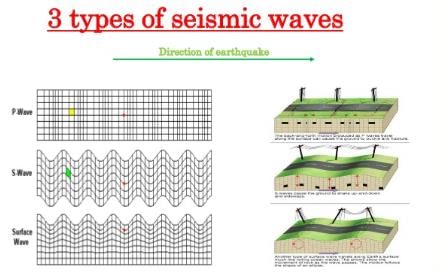Class 7 Exam > Class 7 Questions > name three type of earthquake waves Related: ...
Start Learning for Free
name three type of earthquake waves
? Related: Our Changing Earth (Overview)
Verified Answer
name three type of earthquake waves Related: Our Changing Earth (Over...
Primary (or P-waves): These waves can travel through fluids and solids and are longitudinal - this means they transfer their energy through compression, like a slinky forming compressed areas when you push one end (sound is also an example of a longitudinal wave).
This also means that they transfer energy parallel to the direction of the wave, so if a wave is travelling north to south, the energy will be transferred in this direction.
P-waves are the fastest of the three seismic waves
.

Secondary (or S-waves): S-waves cannot travel through air or water, only through solids, but they have a larger amplitude (this is the height of a wave, measured from the highest point to the middle line) so are more destructive in the case of an earthquake.
They are transverse waves, meaning they transfer energy perpendicular (at right angles) to the direction of the wave - like a rope being shaken up and down (this is like the classic up and down wave associated with light).
S-waves are slower than P-waves.

Surface Waves (of which there are two types - Love and Rayleigh waves): The final type of seismic wave occurs along the boundary between two different substances (e.g. rock and air). They can be either longitudinal (Rayleigh) or transverse (Love and Rayleigh).
These waves travel slower than both S and P waves, but have a higher amplitude and so can be the most destructive of all the seismic waves.
 This question is part of UPSC exam. View all Class 7 courses
This question is part of UPSC exam. View all Class 7 courses
Most Upvoted Answer
name three type of earthquake waves Related: Our Changing Earth (Over...
P waves, s waves ,n wave
Attention Class 7 Students!
To make sure you are not studying endlessly, EduRev has designed Class 7 study material, with Structured Courses, Videos, & Test Series. Plus get personalized analysis, doubt solving and improvement plans to achieve a great score in Class 7.

|
Explore Courses for Class 7 exam
|

|
Similar Class 7 Doubts
name three type of earthquake waves Related: Our Changing Earth (Overview)?
Question Description
name three type of earthquake waves Related: Our Changing Earth (Overview)? for Class 7 2024 is part of Class 7 preparation. The Question and answers have been prepared according to the Class 7 exam syllabus. Information about name three type of earthquake waves Related: Our Changing Earth (Overview)? covers all topics & solutions for Class 7 2024 Exam. Find important definitions, questions, meanings, examples, exercises and tests below for name three type of earthquake waves Related: Our Changing Earth (Overview)?.
name three type of earthquake waves Related: Our Changing Earth (Overview)? for Class 7 2024 is part of Class 7 preparation. The Question and answers have been prepared according to the Class 7 exam syllabus. Information about name three type of earthquake waves Related: Our Changing Earth (Overview)? covers all topics & solutions for Class 7 2024 Exam. Find important definitions, questions, meanings, examples, exercises and tests below for name three type of earthquake waves Related: Our Changing Earth (Overview)?.
Solutions for name three type of earthquake waves Related: Our Changing Earth (Overview)? in English & in Hindi are available as part of our courses for Class 7.
Download more important topics, notes, lectures and mock test series for Class 7 Exam by signing up for free.
Here you can find the meaning of name three type of earthquake waves Related: Our Changing Earth (Overview)? defined & explained in the simplest way possible. Besides giving the explanation of
name three type of earthquake waves Related: Our Changing Earth (Overview)?, a detailed solution for name three type of earthquake waves Related: Our Changing Earth (Overview)? has been provided alongside types of name three type of earthquake waves Related: Our Changing Earth (Overview)? theory, EduRev gives you an
ample number of questions to practice name three type of earthquake waves Related: Our Changing Earth (Overview)? tests, examples and also practice Class 7 tests.

|
Explore Courses for Class 7 exam
|

|
Suggested Free Tests
Signup for Free!
Signup to see your scores go up within 7 days! Learn & Practice with 1000+ FREE Notes, Videos & Tests.

























